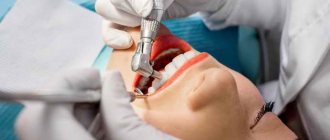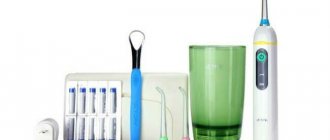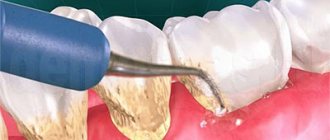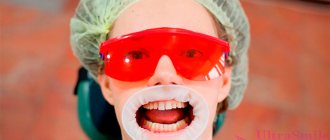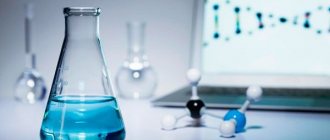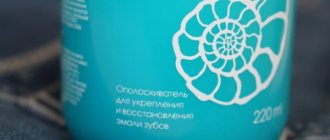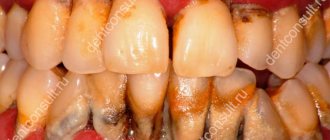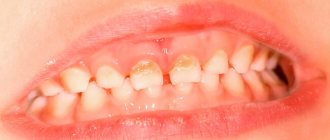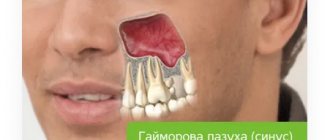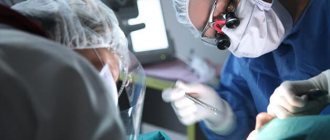Modern methods of professional teeth cleaning are safe and comfortable for the patient. The procedure can be performed even during pregnancy.
Complex cleaning is practically painless; in very rare cases, anesthesia is required. Removal of hard dental deposits and soft plaque is carried out in several stages:
- Tartar removal. First, all hard dental deposits are removed. The procedure is carried out using ultrasound.
- Cleansing using the Air Flow device. Under the influence of water pressure containing abrasive particles, tooth enamel is not only cleaned of soft plaque, but also whitened to its natural shade.
- Polishing. After brushing, the surface of the teeth becomes slightly rough, which will contribute to the rapid accumulation of plaque. To avoid this, the tooth surface is treated with special discs and bristles. After the procedure, the enamel becomes smooth and protected from the effects of pathogenic microflora.
- Treatment with antiseptics. To prevent the spread of infection and to prevent gum inflammation, the oral cavity is treated with an antiseptic solution.
- Fluoridation. After cleaning, the teeth are coated with fluoride varnish to strengthen and reduce the sensitivity of the enamel.
- Applying therapeutic bandages. In case of severe gum inflammation and periodontal bleeding, special therapeutic dressings are applied. The dressings may contain antiseptics, antiviral drugs, and antibiotics.
Inflammation after cleaning
The main cause of inflammation is increased sensitivity of teeth and gums. Increased sensitivity may be an individual characteristic of the patient's body, or it may be a consequence of gum pathologies such as gingivitis, periodontitis or periodontal disease. Sometimes the cause of discomfort can be deep tartar, the removal of which caused inflammation. If you follow all the hygienist’s recommendations, the discomfort will disappear within a few hours after the procedure.
Also, the causes of inflammation after brushing can be an incorrectly selected toothbrush and toothpaste, as well as injury to soft tissues due to careless brushing of teeth. That is why it is very important to follow all the specialist’s recommendations. After brushing the teeth, the hygienist shows the patient how to brush their teeth properly. In addition, the doctor selects a brush, paste, dental floss and additional oral care products that are suitable for the patient.
Clinical researches
Repeated clinical studies have proven that regular use of preventive toothpaste ASEPTA ACTIVE for a month can reduce bleeding gums by 60%, improve the overall condition of the oral cavity by 44% and reduce inflammation by 33%.
Sources:
- Clinical and laboratory assessment of the influence of domestic therapeutic and prophylactic toothpaste based on plant extracts on the condition of the oral cavity in patients with simple marginal gingivitis. Doctor of Medical Sciences, Professor Elovikova T.M.1, Candidate of Chemical Sciences, Associate Professor Ermishina E.Yu. 2, Doctor of Technical Sciences Associate Professor Belokonova N.A. 2 Department of Therapeutic Dentistry USMU1, Department of General Chemistry USMU2
- Study of the clinical effectiveness of treatment and prophylactic agents of the Asepta line in the treatment of inflammatory periodontal diseases (A.I. Grudyanov, I.Yu. Aleksandrovskaya, V.Yu. Korzunina) A.I. GRUDYANOV, Doctor of Medical Sciences, Prof., Head of Department I.Yu. ALEXANDROVSKAYA, Ph.D. V.Yu. KORZUNINA, asp. Department of Periodontology, Central Research Institute of Dentistry and Maxillofacial Surgery, Rosmedtekhnologii, Moscow
- Report on the determination/confirmation of the preventive properties of personal oral hygiene products “ASEPTA PLUS” Remineralization doctor-researcher A.A. Leontyev, head Department of Preventive Dentistry, Doctor of Medical Sciences, Professor S.B. Ulitovsky First St. Petersburg State Medical University named after. acad. I.P. Pavlova, Department of Preventive Dentistry
- Clinical studies of antisensitive toothpaste “Asepta Sensitive” (A.A. Leontyev, O.V. Kalinina, S.B. Ulitovsky) A.A. LEONTIEV, dentist O.V. KALININA, dentist S.B. ULITOVSKY, Doctor of Medical Sciences, Prof. Department of Therapeutic Dentistry, St. Petersburg State Medical University named after. acad. I.P. Pavlova
Rehabilitation after the procedure
To prevent gum inflammation from starting after the procedure, and for the results to last for a long time, the patient is required to properly care for the oral cavity.
What is required from the patient:
- Do not consume coloring foods and drinks for the first 24 hours after the procedure. These products include: colored fruits, vegetables and berries, coffee, red wine and natural juices.
- Immediately after the procedure, do not drink too hot or cold drinks.
- Immediately after brushing, replace the old toothbrush with a new one.
- Not only use a toothbrush twice a day, but also use dental floss and irrigator at least once a day.
- Be sure to visit your dentist every six months for a routine preventive examination.
- Do not neglect professional teeth cleaning, undergo the procedure regularly according to the indications of a specialist. As a rule, doctors recommend undergoing a comprehensive cleaning twice a year.
Do your teeth hurt after brushing? Let's figure it out!
A snow-white smile and beautiful, straight teeth these days have become not just very popular, but also an extremely necessary feature of appearance, on which the quality of a person’s social communication, his professional career, and success in his personal life depend. Nowadays, many people use the services of specialists working in the field of aesthetic dentistry and regularly undergo professional dental cleaning. But not everyone is aware of the intricacies and features of such a procedure, so they wonder why their teeth hurt after brushing , for example, with the advertised safe ultrasound?
Learn more about the benefits of teeth whitening and teeth cleaning
Causes of the inflammatory process
Inflammation of the gums after cleaning tartar most often occurs in people with sensitive enamel. The inflammatory process can be triggered by:
- existing diseases of the oral cavity - caries, pulpitis, periodontitis,
- microcracks in tooth enamel,
- toothpastes with abrasive components,
- traumatization of soft tissues and mucous membranes with a toothbrush with hard bristles.
When several factors are combined, the likelihood of developing an inflammatory process increases.
Surgery
If the gums are severely inflamed and there are deep periodontal pockets, standard professional cleaning may not be effective. To combat inflammation in such cases, surgical treatment is indicated.
- Flap surgery - cutting off the affected areas of soft tissue, removing bacterial deposits under the gum, applying sutures.
- Open curettage is effective for periodontitis and is aimed at deep cleansing of periodontal pockets from granulations and tartar.
The doctor will determine the appropriate treatment tactics after examining the patient.
General recommendations
After professional hygiene, tooth enamel becomes thinner and requires at least two weeks to restore. In addition, when removing hard plaque, the gums suffer, and the degree of trauma depends on their initial condition. For successful rehabilitation and consolidation of the results obtained, dentists at the Atlantis Dental clinic recommend adhering to a set of measures.
- It is necessary to use a toothbrush with soft bristles, as well as a toothpaste with an abrasiveness index (RDA) from 30 to 50 and a high content of minerals - calcium, fluoride, etc.
- After each meal, the mouth is rinsed with a solution that does not contain alcohol, for example, Miramistin or Chlorhexidine. Despite the fact that ethanol is a powerful antiseptic, it irritates and dries the injured mucous membrane. This effect leads to inflammation and pain.
- For rapid tissue regeneration, relief of hyperemia and bleeding of the gums, it is recommended to apply anti-inflammatory gels to the gums two to three times a day. The most effective drug is Metrogyl Denta.
- The use of herbal infusions is excluded, since they contain coloring pigments and intensely stain tooth enamel.
- Hygienic procedures are carried out at least twice a day. Irrigators, dental brushes and floss are used to clean the interdental spaces.
- In some cases, the doctor may prescribe painkillers and anti-inflammatory drugs.
For maximum effect from the procedure, regular visits to a hygienist are required - at least twice a year. Particular attention should be paid to maintaining a healthy lifestyle and choosing care products.
The appointment includes consultation and drawing up a treatment plan with cost determination
sign up for a free consultation
Not ready for an in-person consultation with a doctor? Ask your question by phone
You must refrain from any food or drinks for an hour after the procedure. If remineralization therapy was carried out, the time increases several times. The first meal may include:
- soups without tomato;
- dairy products;
- casseroles;
- boiled beef, poultry, fish;
- porridge;
- bananas;
- vegetables after heat treatment.
During the recovery period, which takes two to three weeks, you should avoid foods with natural or artificial colors. Gradually, fresh fruits and vegetables are introduced into the diet: apples, pears, carrots, cabbage.
Plant products with a solid structure prevent plaque formation and put stress on bone tissue, which improves blood circulation.
What should you not eat after brushing your teeth?
In the first days after the procedure, consuming products with coloring pigments can cause darkening of the enamel. The following should be excluded from the diet:
- tea, coffee and other drinks with dyes;
- spices (turmeric, mustard, paprika, etc.);
- chocolate, cocoa;
- red berries (cherries, blackberries, blueberries);
- beets, carrots, cabbage.
Drinks and dishes should not be very hot or cold, and you should not eat sour, spicy or too salty foods.
Caffeinated drinks - to drink or not to drink?
Tea and coffee contain tannins and coloring agents that give tooth enamel a yellow-brown tint. Therefore, after professional hygiene, you should completely exclude such products from your diet for several weeks. If necessary, drinks can be diluted with milk or water and consumed through a straw.
Is it possible to smoke?
The habit is especially harmful after professional teeth cleaning.
Resins accumulate on the enamel and around the neck of the crown, forming mineral deposits and contributing to the development of caries. Hot smoke irritates injured mucous tissues, causing bleeding gums and aggravating the inflammatory process. We strongly recommend that you avoid cigarettes, pipes, hookahs and vapes for the first 5-7 days after treatment! It is during this time that the enamel is restored and covered with a protective layer.
Alcohol is prohibited
Some types of alcohol contain dyes, so you should limit your consumption:
- cocktails;
- red wine;
- chilled beer;
- energy drinks and tonics.
Clear or light-colored drinks are allowed, but after drinking them, you must thoroughly rinse your mouth.
Manifestations
The following symptoms indicate an inflammatory process in the gum tissue:
- redness and swelling of the gums,
- bleeding when brushing teeth and eating solid foods,
- bad breath,
- discomfort and pain,
- purulent discharge.
After removing hard plaque from teeth, pain may persist for several hours or days. If the pain does not go away over time and only gets worse, do not put off visiting a doctor.
Why does it hurt to brush healthy teeth if you have hypersensitivity?
Sometimes a dental examination does not reveal caries, pulpitis, periodontitis and other diseases. But the pain during cleaning remains. In this case, most likely, we are talking about increased sensitivity of the teeth.
According to statistics, more than 50% of the population have increased tooth sensitivity. This is the name for a condition in which dentin, a porous layer located under the enamel, is exposed. It contains tubules - microchannels leading to nerve endings. When the dentin tubules are exposed, the nerves become vulnerable to any irritants, the tooth reacts with acute pain to cleaning, touching hot and cold food. Dental hypersensitivity can occur for several reasons:
- eating sour or sweet foods,
- too much pressure when cleaning or incorrect selection of bristles stiffness;
- habit of grinding teeth;
- professional teeth cleaning, whitening.
These reasons can cause thinning of the enamel, promote the growth of bacteria and have a destructive effect on the gums, resulting in increased tooth sensitivity.
This condition causes serious discomfort to a person and prevents them from living a normal life. Ordinary everyday activities - eating, brushing and rinsing teeth, exposure to cold air - cause pain and distract attention from other activities. People with this problem find it difficult to concentrate on work or school, because the slightest reason can trigger another attack of pain.
